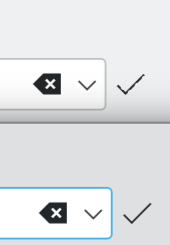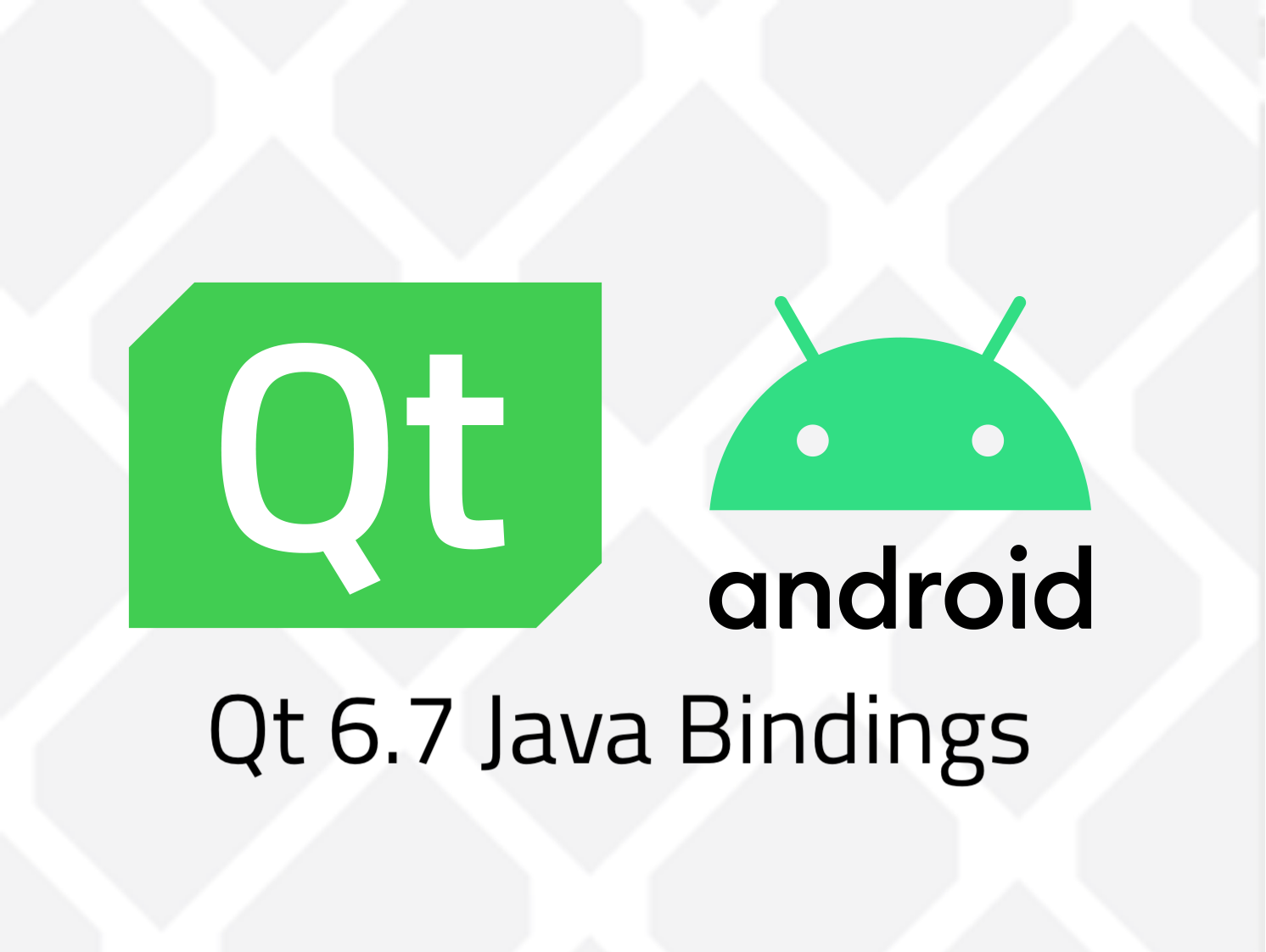Planet KDE
Debug symbols for all!
When running Linux software and encountering a crash, and you make a bug report about it (thank you!), you may be asked for backtraces and debug symbols.
And if you're not developer you may wonder what in the heck are those?
I wanted to open up this topic a bit, but if you want more technical in-depth look into these things, internet is full of info. :)
This is more a guide for any common user who encounters this situation and what they can do to get these mystical backtraces and symbols and magic to the devs.
BacktraceWhen developers ask for a backtrace, they're basically asking "what are the steps that caused this crash to happen?" Debugger software can show this really nicely, line by line. However without correct debug symbols, the backtrace can be meaningless.
But first, how do you get a backtrace of something?
On systems with systemd installed, you often have a terminal tool called coredumpctl. This tool can list many crashes you have had with software. When you see something say "segmentation fault, core dumped", this is the tool that can show you those core dumps.
So, here's a few ways to use it!
How to see all my crashes (coredumps)Just type coredumpctl in terminal and a list opens. It shows you a lot of information and last the app name.
How to open a specific coredump in a debuggerFirst, check from the plain coredumpctl list the coredump you want to check out. Easiest way to deduce it is to check the date and time. After that, there's something called PID number, for example 12345. You can close the list by pressing q and then type coredumpctl debug 12345.
This will often open GDB, where you can type bt for it to start printing the backtrace. You can then copy that backtrace. But there's IMO easier way.
Can I just get the backtrace automatically in a file..?If you only want the latest coredump of the app that crashed on you, then print the backtrace in a text file that you can just send to devs, here's a oneliner to run in terminal:
coredumpctl debug APP_NAME_HERE -A "-ex bt -ex quit" |& tee backtrace.txtYou can also use the PID shown earlier in place of the app name, if you want some specific coredump.
The above command will open the coredump in a debugger, then run bt command, then quit, and it will write it all down in a file called backtrace.txt that you can share with developers.
As always when using debugging and logging features, check the file for possible personal data! It's very unlikely to have anything personal data, BUT it's still a good practice to check it!
Here's a small snippet from a backtrace I have for Kate text editor:
#0 __pthread_kill_implementation (threadid=<optimized out>, signo=signo@entry=6, no_tid=no_tid@entry=0) at pthread_kill.c:44 ... #18 0x00007f5653fbcdb9 in parse_file (table=table@entry=0x19d5a60, file=file@entry=0x19c8590, file_name=file_name@entry=0x7f5618001590 "/usr/share/X11/locale/en_US.UTF-8/Compose") at ../src/compose/parser.c:749 #19 0x00007f5653fc5ce0 in xkb_compose_table_new_from_locale (ctx=0x1b0cc80, locale=0x18773d0 "en_IE.UTF-8", flags=<optimized out>) at ../src/compose/table.c:217 #20 0x00007f565138a506 in QtWaylandClient::QWaylandInputContext::ensureInitialized (this=0x36e63c0) at /usr/src/debug/qt6-qtwayland-6.6.0-1.fc39.x86_64/src/client/qwaylandinputcontext.cpp:228 #21 QtWaylandClient::QWaylandInputContext::ensureInitialized (this=0x36e63c0) at /usr/src/debug/qt6-qtwayland-6.6.0-1.fc39.x86_64/src/client/qwaylandinputcontext.cpp:214 #22 QtWaylandClient::QWaylandInputContext::filterEvent (this=0x36e63c0, event=0x7ffd27940c50) at /usr/src/debug/qt6-qtwayland-6.6.0-1.fc39.x86_64/src/client/qwaylandinputcontext.cpp:252 ...The first number is the step where we are. Step #0 is where the app crashes. The last step is where the application starts running. Keep in mind though that even the app crashes at #0 that may be just the computer handling the crash, instead of the actual culprit. The culprit for the crash can be anywhere in the backtrace. So you have to do some detective work if you want to figure it out. Often crashes happen when some code execution path goes in unexpected route, and the program is not prepared for that.
Remember that you will, however, need proper debug symbols for this to be useful! We'll check that out in the next chapter.
Debug symbolsDebug symbols are something that tells the developer using debugger software, like GDB, what is going on and where. Without debugging symbols the debugger can only show the developer more obfuscated data.
I find this easier to show with an example:
Without debug symbols, this is what the developer sees when reading the backtrace:
0x00007f7e9e29d4e8 in QCoreApplication::notifyInternal2(QObject*, QEvent*) () from /lib64/libQt5Core.so.5Or even worse case scenario, where the debugger can't read what's going on but only can see the "mangled" names, it can look like this:
_ZN20QEventDispatcherGlib13processEventsE6QFlagsIN10QEventLoop17ProcessEventsFlagEENow, those are not very helpful. At least the first example tells what file the error is happening in, but it doesn't really tell where. And the second example is just very difficult to understand what's going on. You don't even see what file it is.
With correct debug symbols installed however, this is what the developer sees:
QCoreApplication::notifyInternal2(QObject*, QEvent*) (receiver=0x7fe88c001620, event=0x7fe888002c20) at kernel/qcoreapplication.cpp:1064As you can see, it shows the file and line. This is super helpful since developers can just open the file in this location and start mulling it over. No need to guess what line it may have happened, it's right there!
So, where to get the debug symbols?Every distro has it's own way, but KDE wiki has an excellent list of most common operating systems and how to get debug symbols for them: https://community.kde.org/Guidelines_and_HOWTOs/Debugging/How_to_create_useful_crash_reports
As always, double check with your distros official documentation how to proceed. But the above link is a good starting point!
But basically, your package manager should have them. If not, you will have to build the app yourself with debug symbols enabled, which is definitely not ideal.. If the above list does not have your distro/OS, you may have to ask the maintainers of your distro/OS for help with getting the debug symbols installed.
Wait, which ones do I download?!Usually the ones for the app that is crashing. Sometimes you may also need include the libraries the app is using.
There is no real direct answer this, but at the very least, get debug symbols for the app. If developers need more, they will ask you to install the other ones too.
You can uninstall the debug symbols after you're done, but that's up to you.
Thanks for reading!I hope this has been useful! I especially hope the terminal "oneliner" command mentioned above for printing backtraces quickly into a file is useful for you!
Happy backtracing! :)
Improving the qcolor-from-literal Clazy check
For all of you who don't know, Clazy is a clang compiler plugin that adds checks for Qt semantics. I have it as my default compiler, because it gives me useful hints when writing or working with preexisting code. Recently, I decided to give working on the project a try! One bigger contribution of mine was to the qcolor-from-literal check, which is a performance optimization. A QColor object has different constructors, this check is about the string constructor. It may accept standardized colors like “lightblue”, but also color patterns. Those can have different formats, but all provide an RGB value and optionally transparency. Having Qt parse this as a string causes performance overhead compared to alternatives.
Fixits for RGB/RGBA patternsWhen using a color pattern like “#123” or “#112233”, you may simply replace the string parameter with an integer providing the same value. Rather than getting a generic warning about using this other constructor, a more specific warning with a replacement text (called fixit) is emitted.
testf4ile.cpp:92:16: warning: The QColor ctor taking RGB int value is cheaper than one taking string literals [-Wclazy-qcolor-from-literal] QColor("#123"); ^~~~~~ 0x112233 testfile.cpp:93:16: warning: The QColor ctor taking RGB int value is cheaper than one taking string literals [-Wclazy-qcolor-from-lite QColor("#112233"); ^~~~~~~~~ 0x112233In case a transparency parameter is specified, the fixit and message are adjusted:
testfile.cpp:92:16: warning: The QColor ctor taking ints is cheaper than one taking string literals [-Wclazy-qcolor-from-literal] QColor("#9931363b"); ^~~~~~~~~~~ 0x31, 0x36, 0x3b, 0x99 Warnings for invalid color patternsNext to providing fixits for more optimized code, the check now verifies that the provided pattern is valid regarding the length and contained characters. Without this addition, an invalid pattern would be silently ignored or cause an improper fixit to be suggested.
.../qcolor-from-literal/main.cpp:21:28: warning: Pattern length does not match any supported one by QColor, check the documentation [-Wclazy-qcolor-from-literal] QColor invalidPattern1("#0000011112222"); ^ .../qcolor-from-literal/main.cpp:22:28: warning: QColor pattern may only contain hexadecimal digits [-Wclazy-qcolor-from-literal] QColor invalidPattern2("#G00011112222"); Fixing a misleading warning for more precise patternsIn case a “#RRRGGGBBB” or “#RRRRGGGGBBBB” pattern is used, the message would previously suggest using the constructor taking ints. This would however result in an invalid QColor, because the range from 0-255 is exceeded. QRgba64 should be used instead, which provides higher precision.
I hope you find this new or rather improved feature of Clazy useful! I utilized the fixits in Kirigami, see https://invent.kde.org/frameworks/kirigami/-/commit/8e4a5fb30cc014cfc7abd9c58bf3b5f27f468168. Doing the change manually in Kirigami would have been way faster, but less fun. Also, we wouldn't have ended up with better tooling :)
Events in 2024
Having ended 2023 with attending 37C3 the new years starts with planning and booking for conferences and events I want to attend in 2024.
My Events in 2024 FOSDEM
February 3-4 in Brussels, Belgium. I’ll be speaking about semantic data extraction in KMail and Nextcloud Mail in the Modern Email devroom.
There’s also going to be a Railways and Open Transport devroom again which I’m particularly looking forward to, and of course the KDE stand.
OSM Hack WeekendFebruary 24-25 in Karlruhe, Germany (wiki).
Based on historical patterns another such weekend can probably be expected for autumn, and a similar pair of events might also happen in Berlin again. As time permits I’ll try to join those as well.
FOSSGIS Konferenz
March 20-23 in Hamburg, Germany. Together with Tobias Knerr I’ll be hosting a session about OSM indoor mapping.
KDE Akademy
September 07-12 in Würzburg, Germany. It would need a pandemic for me to miss that one.
38C3And for concluding 2024 there’s then going to be the 38th Chaos Communication Congress (38C3), December 27-30, presumably in Hamburg, Germany again. Ticket supply permitting I’d love to go there and hope we’ll have a KDE presence there again.
What’s (still) missingSome events aren’t on the list (yet), for various reasons:
- Linux App Summit (LAS) 2024: No official date and location yet. Obviously something I’d attend again as well, however there’s indications it might not be in Europe this time, and intercontinental travel for a three day event is hard to justify for me.
- State of the Map (SotM) 2024: OSM’s global yearly conference I so far have failed to attend in person. Overlaps with Akademy this year though, and also would require intercontinental travel.
- KDE sprints: None scheduled yet, although there have been first discussion for another KDE PIM sprint at least. Time permitting I’ll of course try to attend anything I’m involved with.
Even with all of that it’s still likely incomplete, typically more things come up during the year or I discover new events to attend along the way. I also haven’t seen anything scheduled from Wikidata or the Open Transport community yet.
Events in KDE ItineraryFor planning travel to events it’s helpful to have the event time and location data in Itineray, without having to enter all that manually. Besides supporting some commonly encountered registration/ticketing systems (e.g. Indico, Pretix) it has also been possible to import events by opening, pasting or dropping URLs to a corresponding Mobilizon or other ActivityPub-compatible source, as well as the URL of the event website directly.
For the latter to work, the website needs schema.org semantic annotations describing the event, as e.g. found on the Akademy website. Since a week ago the FOSS event aggregation site // foss.events also has such annotations, so you can easily import any event from there now as well.
 FOSDEM 2024 event data imported from foss.events in Itinerary.
FOSDEM 2024 event data imported from foss.events in Itinerary.
Looking forward to an exciting year and meeting many of you at events :)
Making Two New High Contrast Themes for KMines
Minesweeper is a tragically underrated puzzle game. While I recall examining the mysterious array of gray squares as a child, it wasn't until adulthood that I took the time to learn the rules of the game. Despite my late start, however, I still count minesweeper as a classic. These days, good minesweeper clones are hard to come by. I settled on GNOME's Mines for a while, but as the look of GTK applications on my QT-based KDE Plasma Desktop sets my teeth on edge, I ditched it for KMines in short order. While I enjoyed the game, I found the themes shipped with KMines a bit dated, so I thought I'd make my own.
 The Clean Blue Dark KMines theme
The Drama #
The Clean Blue Dark KMines theme
The Drama #
I didn't quite know what I was getting into when I started working on my themes. I had expected there'd be a simple way to add themes through the KMines settings menu, or by dropping an SVG somewhere in your file-system. If only it were so simple. Adding a theme to KMines requires setting up a full-on KDE development environment, re-compiling KMines from source each time you want to test it, and then, of course, submitting a merge request to the git repository. Thanks to the help of some very patient souls in various KDE Matrix channels, I was able to work through all of this, but I found the process so tricky that I submited a second merge request, this time to the repository for develop.kde.org, for a page documenting the process. Now I realise that some developers out there are going to read through this and wonder if I was dropped on my head as an infant, but in my defense, when it comes to software development, I'm a humble designer and Jamstack web developer. This is all very new to me, and I was expecting a much more streamlined process for what I saw as simple visual tweaks.
 The Clean Blue Light KMines theme
Why High Contrast #
The Clean Blue Light KMines theme
Why High Contrast #
When submitting my initial design, a KDE contributor who had been helping me via Matrix pointed out that they found the theme difficult to parse visually as the contrast was quite low. I hadn't considered contrast ratios here, my thinking being that I didn't need to; I was just making one theme among many, after all, and users could choose any theme that worked best for them. After some consideration, however, it dawned on me that my theme would likely be the only modern-looking theme in the release, so it would be ideal if it were as accessible as possible. With this in mind, thanks to the feedback of one helpful individual, instead of one pretty but low contrast theme, I decided to make two modern high contrast themes, one light and one dark, targeting the WCAG AAA standard for contrast.
Coming in Plasma 6! #With thanks to those KDE contributors who helped make it happen, the merge request containing these two themes scraped by the skin of its teeth past the closing door of a feature-freeze and will be available with Plasma 6 this February!
Web Review, Week 2024-03
Let’s go for my web review for the week 2024-03.
Cat and Girl - 4000 of My Closest FriendsTags: tech, copyright, law, art, ethics
How does it feel to just want to put something creative out there without being exploited? Very touching comic on the topic.
https://catandgirl.com/4000-of-my-closest-friends/
Tags: tech, ai, ethics
As an industry we definitely should think more often about the consequences of our actions. The incentives are indeed pushing us to go faster without much critical thinking.
https://xeiaso.net/talks/2024/prepare-unforeseen-consequences/
Tags: tech, gpt, war, ethics, business
Unsurprising move, they claim it’s for the betterment of mankind but in practice it’s mostly about capturing as much market share as possible.
https://theintercept.com/2024/01/12/open-ai-military-ban-chatgpt/
Tags: tech, ai, machine-learning, gpt, security, supply-chain
The tone pointing at “open models” is wrong but the research is interesting. It still proves models can be poisoned (open or not) so traceability and secured supply-chains will become very important when using large language models.
Tags: tech, foss, law
Very interesting ruling, this opens the door to more parties being able to sue to enforce the GPL not just the authors.
https://blog.tidelift.com/will-the-new-judicial-ruling-in-the-vizio-lawsuit-strengthen-the-gpl
Tags: tech, vlc, 3d, foss, business
This is a stupid move on Unity’s part… they’re built on LGPL but ban others in their store to have LGPL dependencies. Shame on them. Good move from Videolabs though, wish them lots of success.
https://mfkl.github.io/2024/01/10/unity-double-oss-standards.html
Tags: tech, apple, interoperability, security
Apple keep indeed attracting a bunch of cultists… and this allows them to keep abusing their other customers.
https://pluralistic.net/2024/01/12/youre-holding-it-wrong/#if-dishwashers-were-iphones
Tags: tech, facebook, attention-economy, surveillance
Some more insights on the extent of the companies snitching to Facebook.
Tags: tech, fediverse, facebook
Interesting notes, there seems to be good faith on the Meta side for now… but this leaves more questions than answers still.
https://reb00ted.org/tech/20231208-meta-threads-data-dialogue/
Tags: tech, fediverse, self-hosting, infrastructure
Interesting stats, not that easy to gather. This gives a good overview of where the fediverse instances are hosted though.
https://blog.benjojo.co.uk/post/who-hosts-the-fediverse-instances
Tags: tech, web, fonts, css, optimization
Nice set of tricks to optimize load and render time of webpages.
https://cliffle.com/blog/making-website-faster/
Tags: tech, gpu, machine-learning, security
Interesting vulnerability, not all vendors are impacted though. GPU memory leaks can have unforeseen impacts.
Tags: tech, networking, tools
Looks like an interesting tool to simulate difficult network conditions.
https://github.com/kffl/speedbump
Tags: tech, protocols, data, networking, p2p
Looks like an interesting protocol for resilient peer to peer data stores. Let’s see how it spreads.
Tags: tech, cpu, gpu, computation, economics
A good reminder that even though GPU tend to be faster, the added complexity and price might not be worth it in the end.
https://pythonspeed.com/articles/gpu-vs-cpu/
Tags: tech, git, craftsmanship, tools
Can definitely recommend. The pre-commit project also make managing those a breeze.
https://itnext.io/using-pre-commit-hooks-makes-software-development-life-easier-ef962827aa96
Tags: tech, documentation, writing
Pick your words wisely. If it does happen every time use “will”.
https://jamesg.blog/2024/01/17/will-should/
Tags: tech, engineering, communication
Nice suggestion for talking about your work in various type of situations. Definitely worth trying to frame it like this.
https://tonyfreed.substack.com/p/everyday-storytelling-for-engineers
Tags: tech, remote-working, economics
Interesting report. Apparently so far a more widespread use of remote work doesn’t seem to boost of hinder productivity growth at large scale.
Tags: history, politics
Or why nationalism and war mongering are unwelcome dead ends. I never understood this fascination for Sparta by some people… if you look at what it was without some misplaced romanticism, it definitely looked like an horrible and paranoid environment to live in.
https://slate.com/news-and-politics/2024/01/sparta-300-warriors-history-slavery.html
Bye for now!
Ruqola 2.1 Beta
Ruqola 2.1 Beta (2.0.81) is available for packaging and testing.
Ruqola is a chat app for Rocket.chat. This beta release will build with the current release candidate of KDE Frameworks 6 and KTextAddons allowing distros to start to move away from Qt 5.
URL: https://download.kde.org/unstable/ruqola/
SHA256: 2c4135c08acc31f846561b488aa24f1558d7533b502f9ba305be579d43f81b73
Signed by E0A3EB202F8E57528E13E72FD7574483BB57B18D Jonathan Esk-Riddell [email protected]
https://jriddell.org/esk-riddell.gpg
New programming language needed for KDE?
Disclaimer: I am not one of KDE's masterminds or spokespersons. I am a mere bystander with few unimportant commits. I follow KDE's ecosystem and other developments in the free software world. In the following, I share some thoughts and my personal opinion.
Talks about new programming languagesOpenUK’s 2024 New Year’s Honours List

It’s a pleasure to be on the OpenUK New Year’s Honours list for 2024. There’s some impressive names on there such as Richard Hughes of Packagekit and other projects at Red Hat, Colin Watson who was at Ubuntu with me and I see is now freelance, Mike McQuaid was previously of KDE but is now trying a startup with Mac packager Workbrew for Homebrew.
OpenUK run various activities for open tech in UK countries and KDE currently needs some more helpers for a stall at their State of Open Con in London on Feb 6 and 7 February, if you can help do get in touch.
KDE’s 6th releases will happen next month bringing with it the refresh of code and people that a new major version number can bring, I think KDE’s software in the coming year will continue to impress.
My life fell apart after some family loss last year so I’ve run away to the end of the world at Finesterre in Galicia in Spain for now, let me know if you’re in the area.
On the Road to Plasma 6, Vol. 5
The new year has just begun and we have six weeks left before the final release! The most noticeable change since my last post is obviously that we have decided on the wallpaper to be used in Plasma 6.0! But of course there’s more going on under the hood than just that.
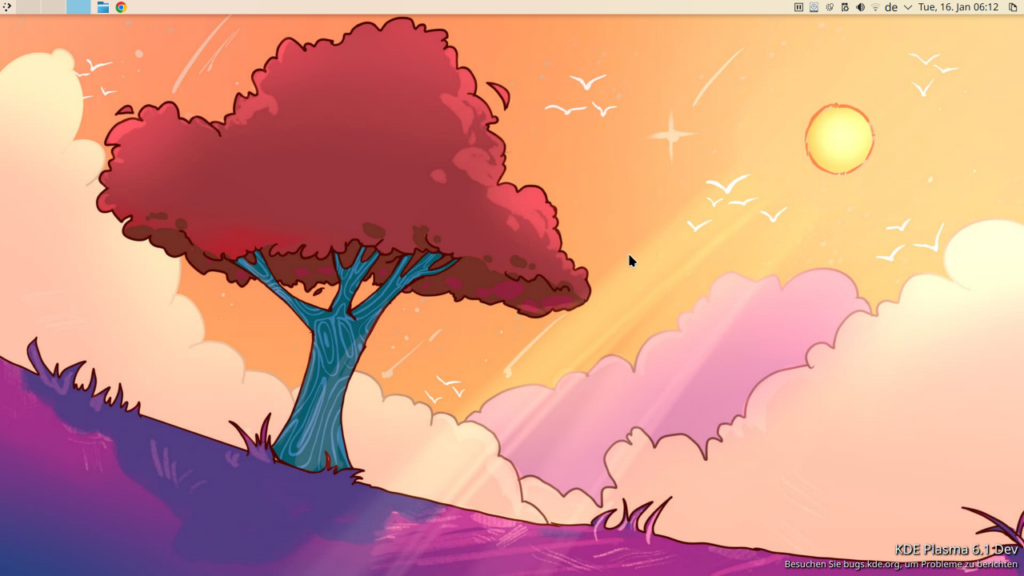 My desktop isn’t usually that tidy
My desktop isn’t usually that tidy
I actually spent most of my time in Qt Wayland rather than KDE code lately but more on that in an upcoming blog post once all my changes have been integrated. Nevertheless, there are still plenty of Wayland-related and other improvements on the Plasma, Frameworks, and KDE Gear side to talk about here.
XDG Foreign EverywhereAfter my previous experience of revamping the KWin Window Killer and having learned how to use the XDG Foreign Protocol (a Wayland protocol for exporting a surface to enable a different process to attach to it), I looked at all the places we have a helper application show a window in another application. This is actually done a lot more often than I thought and thus I added API in KWindowSystem for both exporting and importing windows on Wayland.
Since the export side is only really needed on Wayland, I added (un)exportWindow(QWindow*) functions in KWaylandExtras (a utility namespace with Wayland-specific windowing system functionality) along with a windowExported signal once that has been performed. Setting a foreign parent windows can already be done by using KWindowSystem::setMainWindow or even just QWindow::fromWinId. Both of them take a WId (a long int usually) which means that a string-based handle received from the compositor doesn’t play well with the existing APIs.
In case of KWindowSystem I just added a QString overload. The clever part is that it also understands a long int in a string, thus you just feed a token received as a string from QCommandLineParser or stdin verbatim into the API (even supports using 0x and 0b prefixes) and have it do the right thing on all platforms. That way you only have to special-case the export part for Wayland but the importing side will “just work”. Lifetime of the objects is tied to the actual window and there’s no additional resource tracking logic needed on the application side besides calling those functions, pretty neat.
Both kdialog and keditfiletype support XDG Foreign handles for their relevant attach/parent argument now. It is important to have all “public” command-line tools adjusted for 6.0, thereby knowing it’s a Qt 6 build is enough to tell whether it will understand the string or refuse to start on being unable to parse it as a number. If you know of any other tools that might need adjustment, please do tell. The KAuth Framework for executing privileged tasks as well as the KDE PolicyKit agent also learned how to create and understand those handles. This ensures the password prompt is attached to the window it came from (e.g. when changing settings). There’s still plenty of places where KAuth is used without setting a parent window on the executed action but at least the infrastructure is all there now.
More fractional scaling goodnessOf course I accomplished a few more fixes for fractional scaling. The pixmap created by Item.grabToImage now captures it with the proper scale factor. I also made a fix for then using that grab result in a Drag handler (not merged yet). Together with another fix for Plasma’s Folder View and a KWin change I did a while ago we should finally have crisp pixmaps when dragging icons on the desktop. That was a lot more entangled than I anticipated with the scale factor discarded at pretty much every opportunity along the way.
 Left to right: Original item, original blurry capture, fixed rendering (salmon for illustration)
Left to right: Original item, original blurry capture, fixed rendering (salmon for illustration)
TextInput and TextEdit also re-render themselves immediately when the scale factor changes. This fixes sticky notes on the desktop being blurry until interacted with as well as spin boxes and other editable controls in apps like System Settings. The issue was addressed for labels some time ago but similar treatment was needed for input fields, too.
I talked about Dolphin’s icon rendering in September and now file thumbnails are properly rendered with fractional scaling, too, both in the main file view and the information sidebar. Méven Car worked on high-dpi support for thumbnailers previously and the switch to Frameworks 6 was a good opportunity to change the wire-format used for communication between app and thumbnailer to use a floating-point number for the scale factor instead of an integer. While at it, I also fixed the “tick” icon to accept input on the address bar. Furthermore, mouse cursor theme previews in System Settings are also scaled smoothly. Incidentally, KWin’s bouncing cursor (startup feedback) is scaled according to the cursor size on Wayland, too.
Speaking of Dolphin, the Places sidebar no longer lets you drag one place into another one. While I found that Windows also lets you do that (macOS doesn’t), I don’t really see the point, unless you want to drag your Documents folder to an external hard drive directly? More importantly, though, it makes re-arranging places very finicky since the drop area in-between places is very small. Obviously, it is still possible to drag files and folders from the main view and elsewhere onto an entry in the Places panel to copy/move/link it to the folder or hard drive in question.
In order to fix KWin’s screen edge triggering inadvertently while selecting text in an application and nudging the corner of the screen, I disabled them completely when a mouse cursor is pressed. However, I wasn’t entirely happy with this (and people in the comments weren’t either) and now it’s possible to drag a file into a screen edge and peek at the desktop to drop it there. Making the new overview effects work with drag and drop is going to be a lot more work, so it’s left for a later time. I’d also love to be able to switch virtual desktops while dragging a file, just like we do when touching the screen edge while dragging a window.
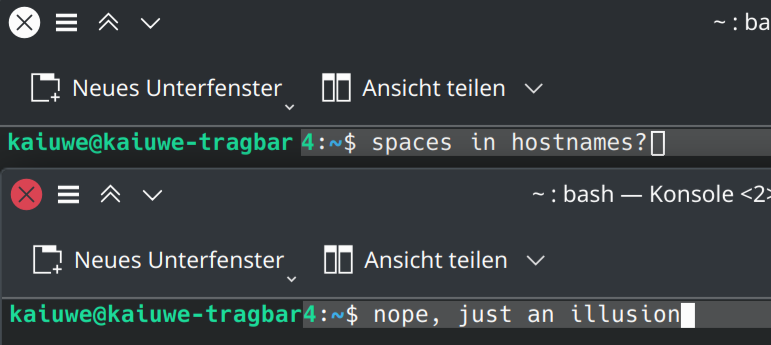 That irksome Konsole font bug finally squashed!
That irksome Konsole font bug finally squashed!
On the subject of broken rendering, I also found a way to improve font rendering in Konsole after the removal of QFont::ForceIntegerMetrics in Qt 6. From what I can tell Konsole entirely relies on the fact that all characters are the same width. Apparently, even with a Monospace font under certain conditions thanks to Hinting and Kerning this may not be entirely the case. Forcing full hinting on the font used seems to ensure that no such trickery is going on. If you still see broken fonts when text is highlighted or selecting it, check that your distribution doesn’t force any particular font settings here.
Anything else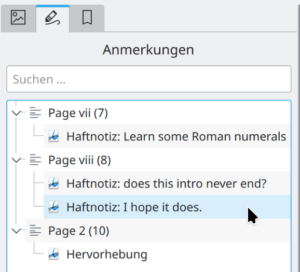 Okular’s annotation bar now showing proper page numbers and annotation contents
Okular’s annotation bar now showing proper page numbers and annotation contents
As a heavy user of Okular’s fantastic annotation feature where you can add labels, sticky notes, shapes, lines, and all sorts of other markers to a (PDF) document, I slightly improved the Annotation sidebar: Custom page numbers are now displayed (pages in a PDF aren’t necessarily strictly numbered but there can be Roman numerals for the index, for example, just like in a real book) and the textual content of the annotation, if any, is shown as well to more easily identify which item is which.
Libksysguard learned SI prefixes for Ampere, Volt, Watt, and Watt-hour units. Should I ever upgrade to a Petawatt solar installation, System Monitor has got me covered. KMessageDialog gained a beep function for playing the relevant notification sound (warning, error, etc), for applications that implement a custom message box and already depend on KWidgetsAddons but don’t want to pull in KNotification just for this. It is now used by Kate’s “Save?” dialog which looks like a message box when saving a single file but because it may also display a list of files is a custom implementation. I also had a look at how to make Qt’s own QMessageBox play the KDE sounds but this is routed though the Qt accessibility framework and I wasn’t sure how to hook into that without jeopardizing more important components of it like the AT-SPI interface.
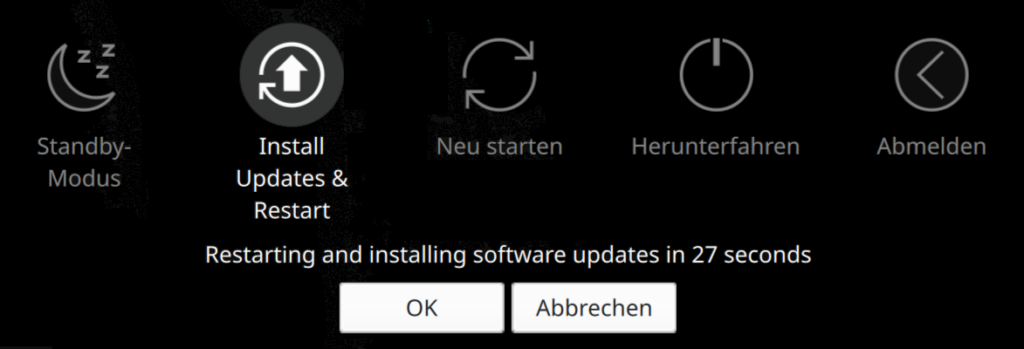 Do you want to install updates or what?
Do you want to install updates or what?
With the prevalence of Offline Updates (i.e. restarting the system and installing updates in a minimal environment) there’s now a dedicated “Reboot & Install Updates” button on the logout screen to skip installing updates and just reboot. This could surely be extended in the future, e.g. shut down without installing updates or install them now instead of on next boot and so on but at least you can now easily reboot the system without installing updates if you want to.
 One of the first changes exclusive to Plasma 6.1: WiFi channel display.
One of the first changes exclusive to Plasma 6.1: WiFi channel display.
Finally, even though we’re all busy squashing any remaining bugs for the 6.0 release, it has been branched off into the “stable” release branch and the repositories are again open for gentle feature development (which includes anything that needs new translations). I just merged a tiny change exclusive to Plasma 6.1: displaying the WiFi channel number next to its frequency in connection details.
Discuss this post on KDE Discuss.
Season Of KDE 2024 Projects
It is a really impressive Season of KDE this year: We have selected a total of 18 projects!
To all of our new contributors, thank you very much for your drive to gain experience and improve FOSS at the same time. The mentors and mentorship team, as well as the broader KDE community, are sure you'll create something fantastic over the next 10 weeks.
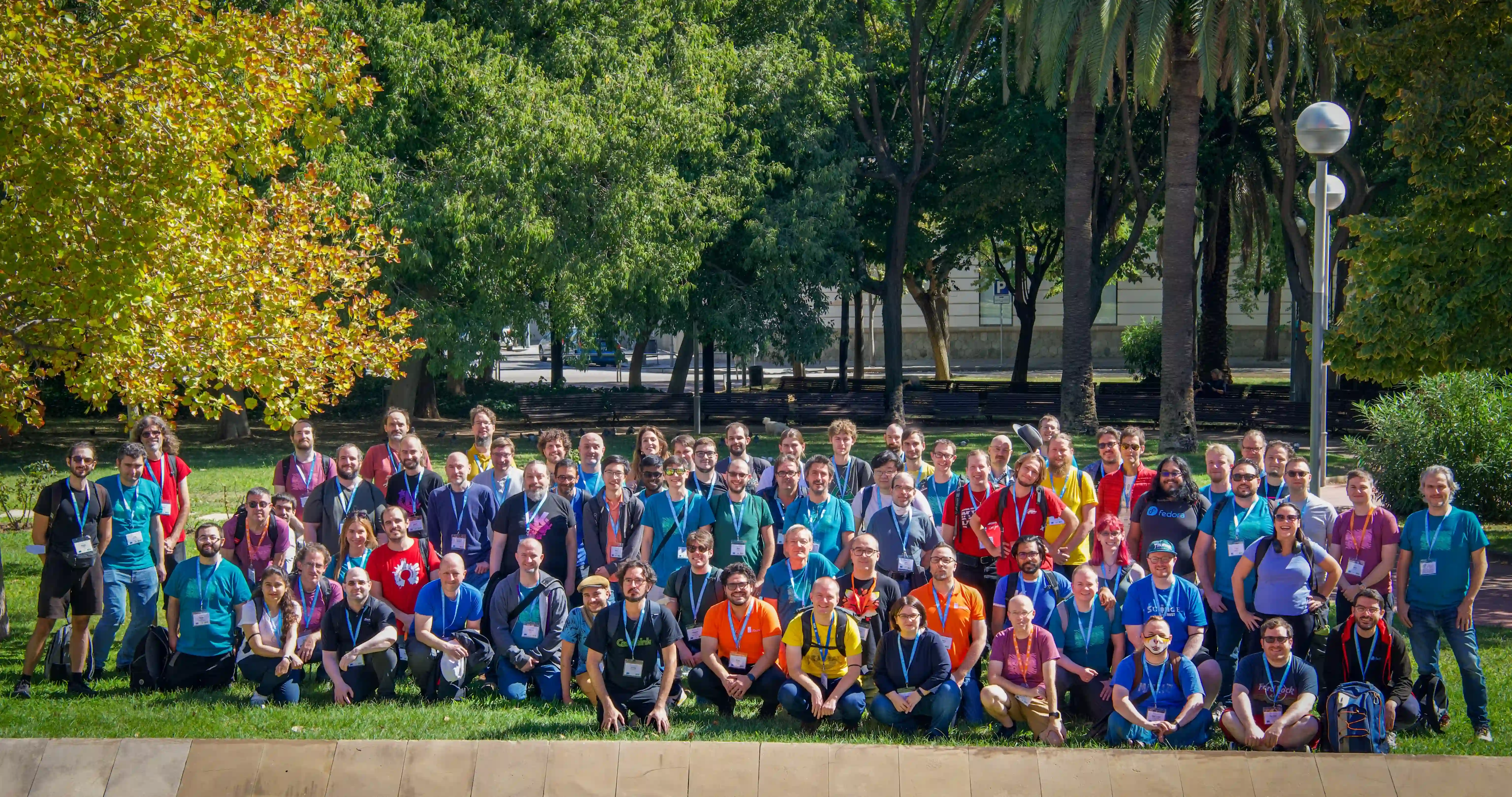 Figure :
Figure :
Group photo of several members of the KDE community at Akademy 2022 in Barcelona, Spain. The KDE community enthusiastically welcomes all new contributors! (Image: CC BY 4.0)
KDE counts on a very active translation community and translates software into over 50 different languages. In SOK 2024, we have 2 projects to translate multiple apps into Hindi:
- Asish Kumar will work on translating KTorrent, KDE connect, Cantor, and Merkuro
- Akash Kumar will work on translating Tellico and Merkuro
They will be mentored by Benson Muite and Raghavendra Kamath.
KdenliveKdenlive brings you all you need to edit and put together your own movies. We have 2 projects for KDE's full-featured video editor:
- Ajay Chauhan will work on adding multi-format rendering to Kdenlive
- Iceneko will enable editing of keyframe curves and advanced keyframe types in Kdenlive
They will be mentored by Julius Künzel and Jean-Baptiste Mardelle.
KDE Eco / AccessibilityThere are 5 new projects that will make measuring the energy consumption of software easier and more integrated in the development pipeline. This will help make KDE software more efficient and environmentally friendly, as well as more accessible at the same time:
- Athul Raj Kollareth will work on improving KdeEcoTest tool using kwin scripting API and uinput
- Amartya Chakraborty will work on adding support for Windows in KdeEcoTest
- Sarthak Negi will work on Testing and development of KEcoLab
- Aakarsh MJ will work on Testing and development of KEcoLab
- Pradyot Ranjan will work on Selenium automation of energy measurements / accessibility tests for KDE applications
They will be mentored by Karanjot Singh, Emmanuel Charruau, Nitin Tejuja, Rishi Kumar, and Joseph P. De Veaugh-Geiss.
Cantor / LabPlotCantor is an application that lets you use your favorite mathematical programming language from within a friendly worksheet interface, while Labplot is KDE's user-friendly data visualization and analysis software. Both projects are closely intertwined, and have had 8 projects approved for SOK:
- Dhairya Majmudar and Saksham Gupta will work together on extending the embedded documentation for supported Computer Algebra Systems Project
- Mahfuza Humayra Mohona will work on enhancing Cantor's and LabPlot's documentation by adding QtHelp Conversion and User Accessibility
- Anshul Dalal will work on integrating KTextEditor into Cantor
- Krish Jain will work on enhancing Cantor with package management capabilities
- Israel Galadima will work on downloading/importing of data sets from kaggle.com
- Mihir Kumar Singh will work on integrating TSDB support to LabPlot
- Raphael Wirth will work on MCAP Support for LabPlot
They will be mentored by Alexander Semke.
KWinKWin is the window manager for KDE's Plasma desktop and it is what gives you complete control over your windows. KWin has had 1 project selected:
- Anurag Thakur will work on moving brightness control to KWin and adding per-screen brightness control
They will be mentored by Xaver Hugl.
The 18 contributors will start developing on January 17 under the guidance of their mentors. SOK will end March 31. Check out the full SOK 2024 timeline.
Let's warmly welcome all of them and make sure their journey with KDE is successful!
You will be able to follow the progress via blog posts published on KDE's planet.
KDE e.V. is looking for a project lead and event manager for environmental sustainability project
KDE e.V. is looking for you as an employee for a new project to promote environmentally-sustainable software and long-term hardware use. You will be the person who makes sure the administration of the project and the organization of the campaigns and workshops are on track and successful. Please see the full job listing for more details about this opportunity.
Applications will be accepted until mid-february, and we look forward to your application.
New countries in KDE Itinerary
Caused by a small discussion about how it is difficult to get from Berlin to Riga by train, and in direct consequence a quick look at how the official app for trains in Latvia finds its connections, I added support for it in KDE Itinerary. KDE Itinerary is KDE’s travel planning app.
After I understood how it works, adding support for new data sources seemed pretty doable, so I directly moved on to do the same for trains in Lithuania as well.
As a result of this, it is now possible to travel from Berlin to Riga with Itinerary and continue further with the local trains there:
The connection is still far from good, but fear I can’t fix that in software.
What still does not work, is directly searching from Berlin to Riga, as that depends on having a single data source that has data on the entire route to find it. So it is necessary to split the route and search for the parts yourself.
Why you can’t always find a route even though there is oneThe main data source for Itinerary in Europe is the API of the “Deutsche Bahn”, the main railway operator in Germany. Its API also has data for neighbouring countries, and even beyond that. According to Jon Worth their data comes from UIC Merits, which is a common system that railway operators can submit their routes to. However that probably comes with high costs, so many smaller operators like the ones in Latvia and Lithuania don’t do that. For that reason there is no such single data source that can route for example from Berlin to Riga.
What most of the operators in Europe do however, is publish schedule data in a common format (GTFS). What is missing so far, is a single service that can route on all of the available data and has an API that we can use. Setting something like this up would require a bit of community and hosting resources, but I am hopeful that we can have something like this in the future.
In the meantime, it already helps to fill in the missing countries one by one, so at least local users can already find their routes in Itinerary, and for Interrail and other cross border travel, people can at least patch routes together.
More countriesThe next country I worked on was Montenegro. The reason for that is that it is close to the area that the DB API can still give results for, and also still has useful train services. Getting their API to work well was a bit more difficult though, as it doesn’t provide some of the information that Itinerary usually depends on. For example coordinates for stations. Those are needed to select where to search for trains going from a station. Luckily, exporting the list of stations and their coordinates from OpenStreetMap was relatively easy and provided me with all the data I needed.
Thanks to that Itinerary can now even show the route on a map properly.
Now only the API for Serbia is missing to actually connect to the part of the network DB knows about.
The new backends are not yet included in any release, but you can already find them in the nightly builds. Be aware that the nightly builds have switched to Qt6 and KF6 faily recently, which means there are still a few rough edges and small bugs in the UI.
On Linux, you can use the nightly flatpak:
On Android, the usual KDE Nightly F-Droid repository has up to date builds.
KDE’s 6th Megarelease – RC1 on Fedora Rawhide!
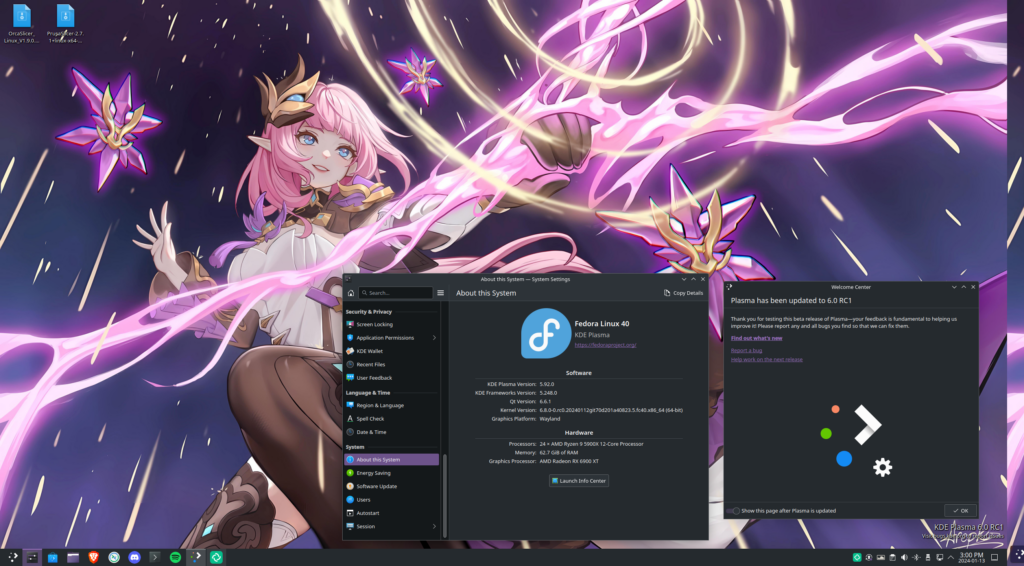
After a few days of work the Fedora KDE SIG is proud to announce the availability of KDE 6th Megarelease Release Candidate 1 on Fedora Rawhide!
For those who like bleeding edge, feel free to try it!
We are very excited and looking forward to Fedora 40 + KDE 6 + Wayland only
Note: right now the update is sitting on testing. If you don’t want to wait a few hours until it reaches stable…
You can access it via a dnf repository like:
KDE Ships Frameworks 5.114.0
Saturday, 13 January 2024
KDE today announces the release of KDE Frameworks 5.114.0.
KDE Frameworks are 83 addon libraries to Qt which provide a wide variety of commonly needed functionality in mature, peer reviewed and well tested libraries with friendly licensing terms. For an introduction see the KDE Frameworks release announcement.
This release is part of a series of planned monthly releases making improvements available to developers in a quick and predictable manner.
New in this version Baloo- [IndexCleaner] Remove no-op recursion over includedFolders
- [ExtractorProcess] Remove unused members
- [TimeEstimator] Cleanup, remove QObject depency
- Use forward declaration for Baloo::Database
- Remove inacurate mimetype check in xattrindexer and indexcleaner
- Fixes to FindLibGit2.cmake (bug 478669)
- Drop unused KF5WindowSystem from cli
- KEmailAddress: Only trim surrounding whitespace between E-Mail addresses instead of also replacing all whitespace within E-Mail address names with a single ASCII space
- Fix license text loading on Android
- Introduce holidays observed in Kenya
- avif: new quality settings
- Update CI template
- HEIF plug-in extended to support HEJ2 format
- kpropertiesdialog: don't trip over malformed Exec (bug 465290)
- WidgetsAskUserActionHandler: fix backport (bug 448532)
- WidgetsAskUserActionHandler: Use QPointer to check the validity of parent widgets (bug 448532)
- Make drawer actions accessible
- KUiServerV2JobTracker: prevent potenial use-after-free (bug 471531)
- DBusRunner: Use /runner as default for X-Plasma-DBusRunner-Path property
- [CI] Fix pipeline include
- Adapt to KAccounts API change
The released code has been GPG-signed using the following key: pub rsa2048/58D0EE648A48B3BB 2016-09-05 David Faure [email protected] Primary key fingerprint: 53E6 B47B 45CE A3E0 D5B7 4577 58D0 EE64 8A48 B3BB
Web Review, Week 2024-02
Let’s go for my web review for the week 2024-02.
Where have all the websites gone?Tags: tech, web, blog, culture
This is in part why I started my web review… maybe I should start a kind of blogroll, or maybe have links to websites I like straight on my front page.
https://www.fromjason.xyz/p/notebook/where-have-all-the-websites-gone/
Tags: tech, surveillance
What could possibly go wrong? Panopticon 2.0 here we come.
Tags: tech, microsoft, windows, email, surveillance
Looks like Microsoft is really catching up fast for its surveillance apparatus to be on par with Google and Meta.
https://proton.me/blog/outlook-is-microsofts-new-data-collection-service
Tags: tech, law, facebook, surveillance, attention-economy
Very welcome complaont, Meta is trying to workaround the GDPR to increase paid accounts. Can only hope they get fined and that this shady practice disappear (they’re not the only ones doing this).
https://noyb.eu/en/meta-ignores-users-right-easily-withdraw-consent
Tags: tech, security
A not so gentle reminder that you shouldn’t get sloppy in the security practices of your services.
Tags: tech, self-hosting, blog, webmention
Looks like a nice way to ease the use of webmentions. Also comes with a command line option not relying on third party hosted service apparently.
Tags: tech, ssh, blog
Very funny hack for a blog comment system.
https://blog.haschek.at/2023/ssh-based-comment-system.html
Tags: tech, ssh, security, tools
Fascinating script which jumps over SSH servers in several hops and replicates itself without a file upload.
https://joshua.hu/ssh-snake-ssh-network-traversal-discover-ssh-private-keys-network-graph
Tags: tech, browser, tls, security
Some of that certificate chain validation is troublesome… in Chrome based browsers it’s even truly insane.
https://blog.benjojo.co.uk/post/browsers-biggest-tls-mistake
Tags: tech, messaging, battery, android
If you’re wondering where your battery power goes… this is a nice list of measures for various clients on Android. It looks like XMPP is still hard to beat.
https://decentim.grafana.net/public-dashboards/92602d3a4aa842ce97812d310077691d?orgId=1
Tags: tech, filesystem
Fascinating exploration of the patterns visible inside ext4 filesystems.
https://buredoranna.github.io/linux/ext4/2020/01/09/ext4-viz.html
Tags: tech, docker, tools
Looks like an interesting tool if you’re dealing with docker image. This kind of analysis is definitely missing from docker itself.
https://github.com/wagoodman/dive
Tags: tech, shader, vulkan, c++
Interesting proof of concept to compile C++ into shaders. This reminds CUDA a bit without being tied to a given GPU brand.
https://shady-gang.github.io/vcc/
Tags: tech, python, type-systems
Interesting trick even though I always cringe at such difference of behavior between runtime and “compile” time.
https://rednafi.com/python/statically_enforcing_frozen_dataclasses/
Tags: tech, python, jit, optimization
Want to better understand the JIT approach introduced in Python 3.13, this is a good little article. This JIT is a first step towards more optimizations.
https://tonybaloney.github.io/posts/python-gets-a-jit.html
Tags: tech, git, version-control, teaching
So, which team are you on when you think about commits in Git?
https://jvns.ca/blog/2024/01/05/do-we-think-of-git-commits-as-diffs–snapshots–or-histories/
Tags: tech, refactoring, craftsmanship, book
Review of the newest book from Kent Beck, I’ll probably check it out and read it.
https://henrikwarne.com/2024/01/10/tidy-first/?
Tags: tech, product-management
Interesting metaphor regarding that feature you have because it is expected but otherwise doesn’t quote work.
https://ntietz.com/blog/the-steak-on-the-menu/
Tags: tech, management
Interesting approach for a manager to give transparency and to clarify expectations.
https://zaidesanton.substack.com/p/how-to-make-your-team-read-your-mind
Tags: tech, hr, hiring
Good list of tips and ideas. This is not necessarily as easy as it sounds. The lack of good metrics doesn’t help (totally understandable though, privacy first).
https://jacobian.org/2024/jan/4/diverse-hiring-playbook/
Bye for now!
KDSoap 2.2.0 Released
 We’re pleased to announce the release of KDSoap version 2.2.0, an update that brings new enhancements to improve both the general build system and client-side functionality.
We’re pleased to announce the release of KDSoap version 2.2.0, an update that brings new enhancements to improve both the general build system and client-side functionality.
KDSoap, a SOAP (“Simple Object Access Protocol“) component rooted in Qt, serves as an essential tool for both client-side and server-side operations. Tailored for C++ programmers using Qt, it not only facilitates the creation of client applications for web services but also empowers developers to seamlessly build web services without requiring additional components like dedicated web servers. For further details on KDSoap, visit here.
What’s New in KDSoap Version 2.2.0?Build System Co-installability: The buildsystem now supports the co-installability of Qt 5 and Qt 6 headers. Qt 6 headers are installed into their dedicated subdirectory. This ensures compatibility with client code and allows co-installation with Qt 5.
Client-Side:
- WS-Addressing Support: The new release adds KDSoapClientInterface::setMessageAddressingProperties(). This addition enables the use of WS-Addressing support specifically with WSDL-generated services.
- SOAP Action Requirement Removal: KDSoap no longer requires a SOAP action for writing addressing properties.
WSDL Parser / Code Generator Changes:
Enhanced -import-path Support: Notable changes have been made to the WSDL parser and code generator, impacting both client and server sides. The update improves -import-path support by incorporating the import path in more areas within the code. This refinement enhances the overall functionality of the parser and code generator.
These updates collectively contribute to a more streamlined and efficient experience for KDSoap users, addressing specific issues and introducing valuable features to facilitate seamless integration with Qt-based applications. For detailed information and to explore these enhancements, we refer to the KDSoap documentation accompanying version 2.2.0 on GitHub.
How to Get Started with KDSoap Version 2.2.0?For existing users, upgrading to the latest version is as simple as downloading the new release from the GitHub page. If you are new to KDSoap, we invite you to explore its capabilities and discover how it can streamline your web service development process.
As always, we appreciate your feedback and contributions to make KDSoap even better. Feel free to reach out to us with any questions, suggestions or bug reports on our GitHub repository.
Thank you for choosing KDSoap, and happy coding!
If you like this article and want to read similar material, consider subscribing via our RSS feed.
Subscribe to KDAB TV for similar informative short video content.
KDAB provides market leading software consulting and development services and training in Qt, C++ and 3D/OpenGL. Contact us.
The post KDSoap 2.2.0 Released appeared first on KDAB.
KDE Gear 24.02 branches created
Make sure you commit anything you want to end up in the KDE Gear 24.02 releases to them
Next Dates:
- January 31: 24.02 RC 2 (24.01.95) Tagging and Release
- February 21: 24.02 Tagging
- February 28: 24.02 Release
https://community.kde.org/Schedules/February_2024_MegaRelease
KTextAddons 1.5.3
KTextAddons is a library with Various text handling addons used by Ruqola and Kontact apps. It can be compiles for both Qt 5 and 6 and distros are advised to compile two builds for each until Ruqola is ported to Qt 6.
URL: https://download.kde.org/stable/ktextaddons/
SHA256: 8a52db8abfa8a9d68d2d291fb0f8be20659fd7899987b4dcafdf2468db0917dc
Changelog
- Drop unused KXmlGui dependency
- Adapt to new KConfigGroup API
- As we exclude emojis we need to remove it from list and not exclude it
- Use proxymodel when exclude emoticons were updated
- Allow to exclude some specific emoticons (Need for ruqola)
- Exclude mock engine => it’s for test
- Remove generate pri support (removed in kf6)
KDE's Megarelease 6 - Release Candidate 1
Every few years we port the key components of our software to a new version of Qt, taking the opportunity to remove cruft and leverage the updated features the most recent version of Qt has to offer us.
KDE's megarelease is less than 50 days away. At the end of February 2024 we will publish Plasma 6, Frameworks 6, and a whole new set of applications in a special edition of KDE Gear all in one go.
If you have been following the updates here, here and here, you will know we are making our way through the testing phase and gradually reaching stability. KDE is making available today the first Release Candidate version of all the software we will include in the megarelease.
As with the Alpha and Beta versions, this is a preview intended for developers and testers. The software provided is nearing stability, but is still not 100% safe to use in a production environment. We still recommend you continue using stable versions of Plasma, Frameworks and apps for your everyday work. But if you do use this, watch out for bugs and report them promptly, so we can solve them.
Read on to find out more about KDE's 6th Megarelease, what it covers, and how you can help make the new versions of Plasma, KDE's apps and Frameworks a success now.
PlasmaPlasma is KDE's flagship desktop environment. Plasma is like Windows or macOS, but is renowned for being flexible, powerful, lightweight and configurable. It can be used at home, at work, for schools and research.

Plasma 6 is the upcoming version of Plasma that integrates the latest version of Qt, Qt 6, the framework upon which Plasma is built.
Plasma 6 incorporates new technologies from Qt and other constantly evolving tools, providing new features, better support for the latest hardware, and supports for the hardware and software technologies to come.
You can be part of the new Plasma. Download and install a Plasma 6-powered distribution (like Neon Unstable) to a test machine and start trying all its features. Check the Contributing section below to find out how you can deliver reports of what you find to the developers.
KDE GearKDE Gear is a collection of applications produced by the KDE community. Gear includes file explorers, music and video players, text and video-editors, apps to manage social media and chats, email and calendaring applications, travel assistants, and much more.
Developers of these apps also rely on the Qt toolbox, so most of the software will also be adapted to use the new Qt6 toolset and we need you to help us test them too.
- KDE Gear 24.02 RC 1 Source Code Info Page
- KDE Gear 24.02 RC 1 Full Changelog
- KDE Gear 24.02 packagers' release notes
KDE's Frameworks add tools created by the KDE community on top of those provided by the Qt toolbox. These tools give developers more and easier ways of developing interfaces and functionality that work on more platforms.
Among many other things, KDE Frameworks provide
- widgets (buttons, text boxes, etc.) that make building your apps easier and their looks more consistent across platforms, including Windows, Linux, Android and macOS
- libraries that facilitate storing and retrieving configuration settings
- icon sets, or technologies that make the integration of the translation workflow of applications easier
KDE's Frameworks also rely heavily on Qt and will also be upgraded to adapt them to the new version 6. This change will add more features and tools, enable your applications to work on more devices, and give them a longer shelf life.
- KDE Frameworks 6 RC 1 Source Code Info Page
- KDE Frameworks 6 RC 1 Full Changelog
- KDE Frameworks 6 packagers release notes
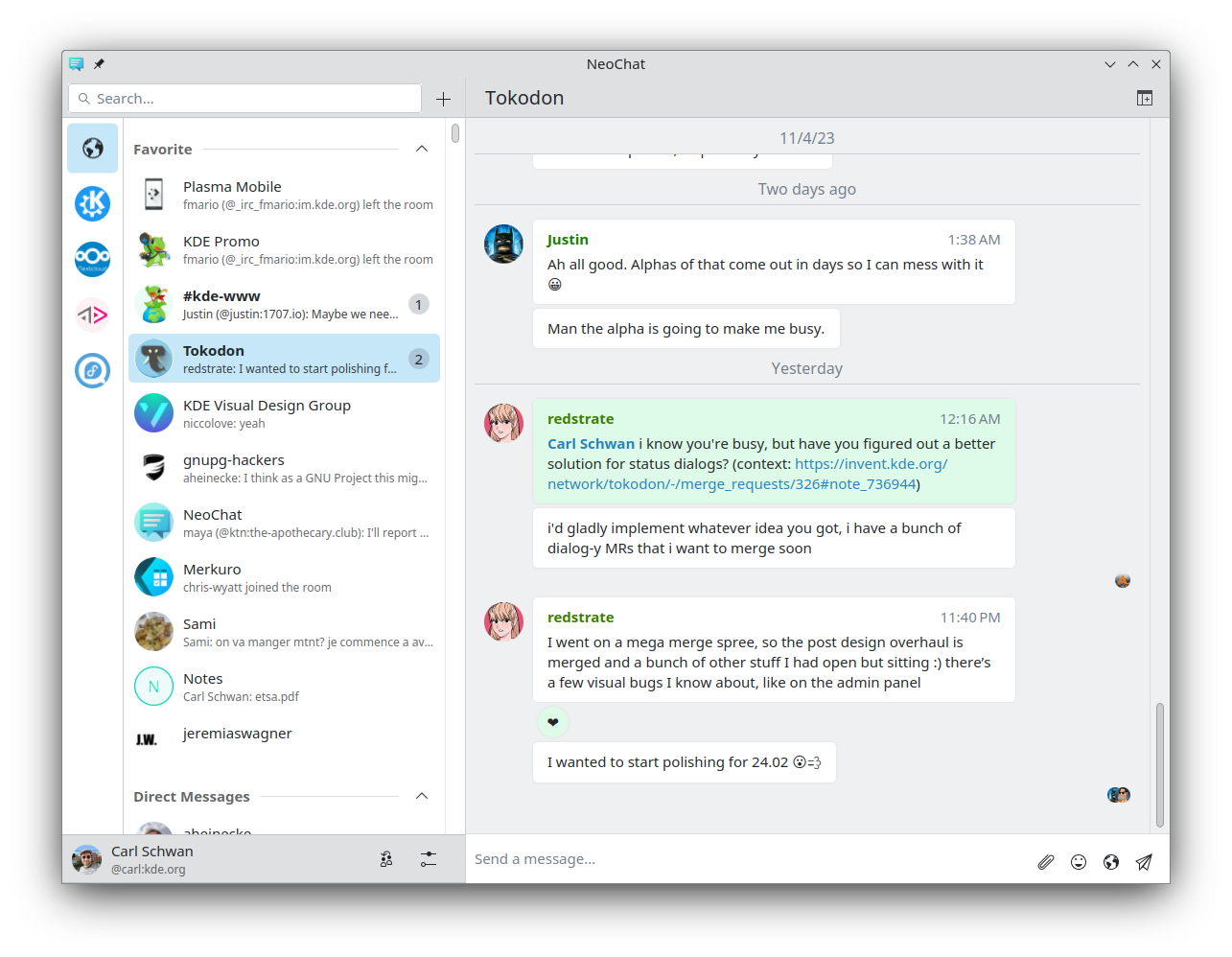
KDE relies on volunteers to create, test and maintain its software. You can help too by...
- Reporting bugs -- When you come across a bug when testing the software included in this Alpha Megarelease, you can report it so developers can work on it and remove it. When reporting a bug
- make sure you understand when the bug is triggered so you can give developers a guide on how to check it for themselves
- check you are using the latest version of the software you are testing, just in case the bug has been solved in the meantime
- go to KDE's bug-tracker and search for your bug to make sure it does not get reported twice
- if no-one has reported the bug yet, fill in the bug report, giving all the details you think are significant.
- keep tabs on the report, just in case developers need more details.
- Solving bugs -- Many bugs are easy to solve. Some just require changing a version number or tweaking the name of a library to its new name. If you have some basic programming knowledge of C++ and Qt, you too can help carry the weight of debugging KDE's software for the grand release in February.
- Joining the development effort -- You may have a deeper knowledge development, and would like to contribute to KDE with your own solutions. This is the perfect moment to get involved in KDE and contribute with your own code.
- Donating to KDE -- Creating, debugging and maintaining the large catalogue of software KDE distributes to users requires a lot of resources, many of which cost money. Donating to KDE helps keep the day-to-day operation of KDE running smoothly and allows developers to concentrate on creating great software. KDE is currently running a drive to encourage more people to become contributing supporters, but you can also give one-time donations if you want.
Pre-release software is only suited for developers and testers. Alpha/Beta/RC software is unfinished, will be unstable and will contain bugs. It is published so volunteers can trial-run it, identify its problems, and report them so they can be solved before the publication of the final product.
The risks of running pre-release software are many. Apart from the hit to productivity produced by instability and the lack of features, using pre-release software can lead to data loss, and, in extreme cases, damage to hardware. That said, the latter is highly unlikely in the case of KDE software.
The version of the software included in KDE's 6th Megarelease is beta software. We strongly recommend you do not use it as your daily driver.
If, despite the above, you want to try the software distributed in KDE's 6th Megarelease, you do so under your sole responsibility, and in the understanding that the main aim, as a tester, you help us by providing feedback and your know-how regarding the software. Please see the Contributing section above.
Android Java Bindings in Qt 6.7
The Qt for Android plugin, introduced more than a decade ago, has been a game-changing change that opened a multitude of possibilities for developers looking to harness the power and flexibility of Qt for Android application development. Since then, many Android, Qt, and plugin changes have been made to support new features. However, neither the overall architecture nor the public Java bindings have changed much. These bindings contain wrappers for the Android Activity. It is about time we did that!

